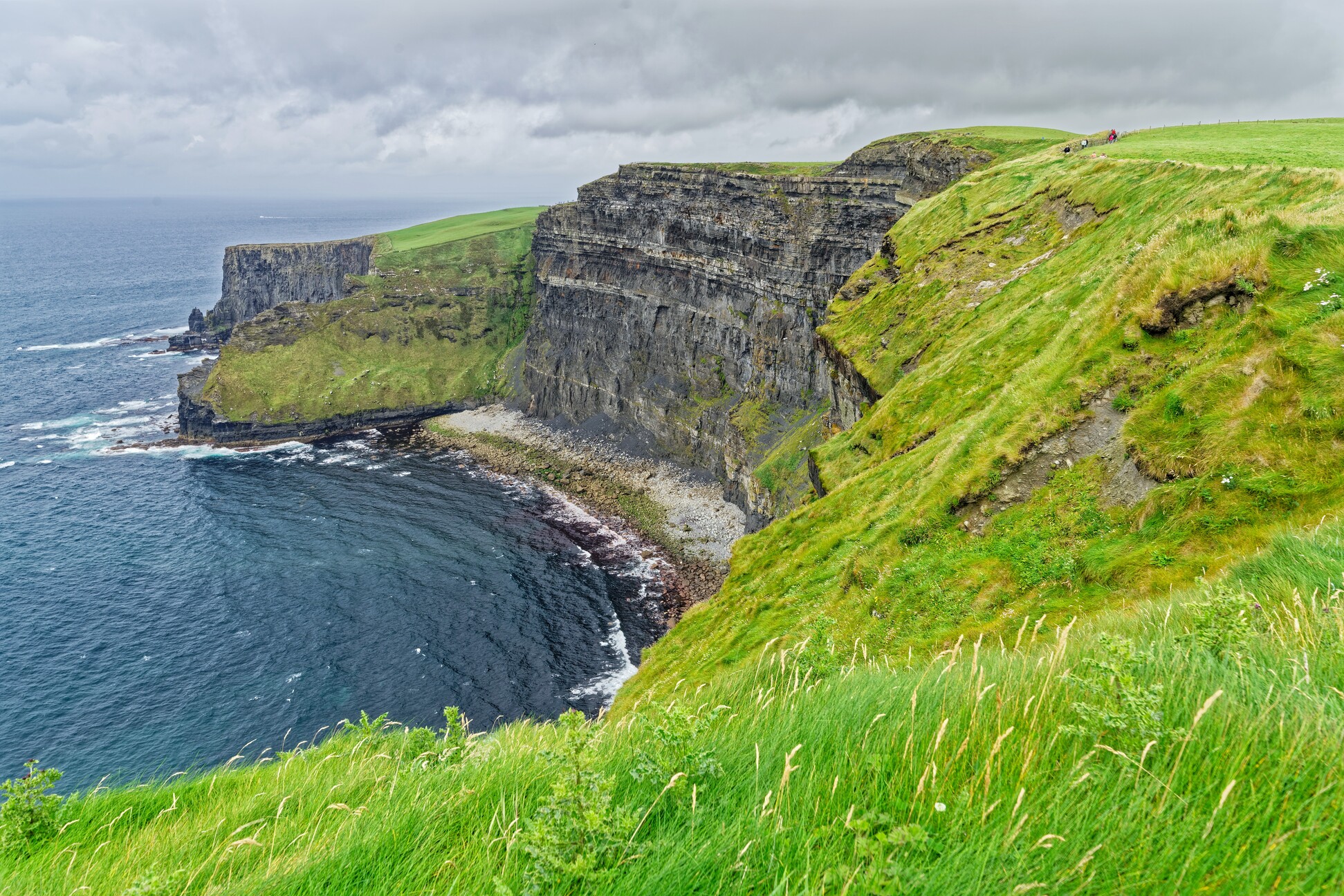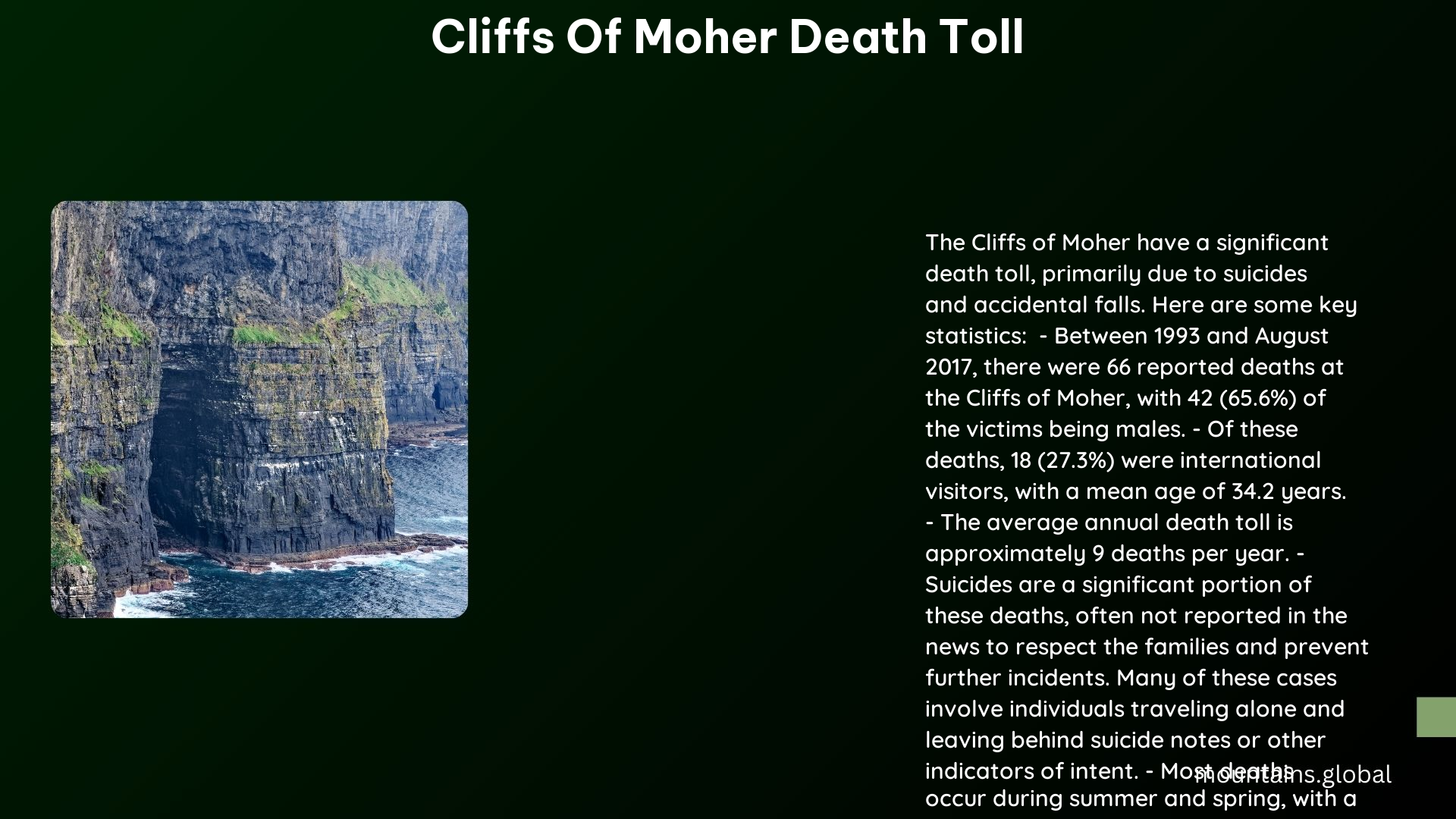The Cliffs of Moher, a stunning natural wonder in Ireland, have unfortunately been the site of numerous tragic incidents over the years. Between 1993 and 2017, 66 deaths were reported, averaging about 2.64 fatalities annually. International visitors accounted for 27.3% of these deaths. Most incidents occur during spring and summer, with weekends being particularly dangerous. Solo travelers, alcohol consumption, and challenging weather conditions are significant risk factors.
What is the Historical Death Toll at the Cliffs of Moher?

The Cliffs of Moher have a somber history when it comes to visitor safety. Let’s break down the numbers:
- Total reported deaths (1993-2017): 66
- Average annual deaths: 2.64
- International visitors: 18 (27.3% of total)
This data provides a stark reminder of the potential dangers at this popular tourist destination. However, it’s important to note that these figures may not fully represent the current situation, as safety measures have evolved over time.
What are the Most Common Types of Accidents?

The majority of fatalities at the Cliffs of Moher result from falls. These accidents can be categorized into several types:
- Accidental falls while walking
- Falls during photography attempts
- Suicides
- Falls potentially influenced by alcohol intoxication
Post-mortem examinations consistently reveal multiple traumatic injuries consistent with falls from great heights, underscoring the severe consequences of these incidents.
When Do Most Accidents Occur?
Timing plays a crucial role in the occurrence of accidents at the Cliffs of Moher. Here’s a breakdown of when most incidents tend to happen:
| Season | Number of Deaths |
|---|---|
| Summer | 7 |
| Spring | 6 |
| Winter | Not specified |
| Autumn | Not specified |
Additionally:
– 44% of deaths (8 out of 18 studied cases) occurred on weekends
– A significant majority (83.3%) of victims were walking alone when the incident occurred
This data suggests that warmer months and weekends see higher visitor numbers, potentially leading to more accidents.
What are the Key Risk Factors?
Several factors contribute to the risk of fatal accidents at the Cliffs of Moher:
-
Solo Travel: A staggering 83.3% of victims were alone when they fell, highlighting the dangers of exploring the cliffs without companionship.
-
Alcohol Consumption: Some cases involved alcohol intoxication, which can impair judgment and balance.
-
Weather Conditions: While specific weather-related data is limited, the cliffs’ environment, including strong winds and potentially slippery surfaces, can increase the risk of accidents.
-
Suicidal Intent: Half of the studied cases (9 out of 18) resulted in suicide or open verdicts, indicating that mental health is a significant factor in some incidents.
-
Photography-Related Risks: Several notable incidents involved visitors attempting to take photos or selfies, leading to fatal falls.
What Notable Incidents Have Occurred Recently?
While the historical data provides valuable insights, recent incidents continue to highlight the ongoing risks:
-
May 2024: A young foreign college student tragically fell to her death while visiting with friends, prompting a major search and rescue operation.
-
January 2019: A 26-year-old Indian national died after falling while taking selfies at the cliffs.
-
June 2007: A Hungarian man in his 20s lost his life after falling while attempting to take photos.
These incidents underscore the persistent dangers, even with increased awareness and safety measures in place.
How are Authorities Addressing Safety Concerns?
In response to the ongoing risks, several safety measures have been implemented:
- Physical Barriers:
- Installation of fencing and barriers in high-risk areas
-
Regular maintenance and upgrades to existing safety structures
-
Warning Systems:
- Prominent display of warning signs throughout the site
-
Multi-lingual safety information to cater to international visitors
-
Emergency Response:
- Rapid response protocols involving the Irish Coast Guard, Gardaí, and other emergency services
-
Regular training and drills to ensure efficient rescue operations
-
Public Awareness Campaigns:
- Ongoing efforts to educate visitors about potential dangers
-
Promotion of safe viewing practices and responsible tourism
-
Guided Tours:
- Encouragement of visitors to join guided tours for safer exploration
- Training for tour guides on safety protocols and emergency procedures
Despite these measures, the rugged nature of the cliffs and unpredictable human behavior continue to pose challenges in completely eliminating risks.
What Can Visitors Do to Stay Safe?
To minimize the risk of accidents, visitors to the Cliffs of Moher should:
- Stay on designated paths and behind safety barriers
- Avoid approaching cliff edges, especially in windy conditions
- Refrain from consuming alcohol before or during the visit
- Be cautious when taking photographs, prioritizing safety over the perfect shot
- Consider joining guided tours for a safer experience
- Pay attention to weather forecasts and avoid visiting during severe conditions
- Travel with companions rather than exploring alone
- Respect all warning signs and follow staff instructions
By adhering to these guidelines, visitors can significantly reduce their risk while still enjoying the breathtaking beauty of the Cliffs of Moher.
References:
– https://www.irishexaminer.com/news/arid-41388562.html
– https://www.midwestradio.ie/index.php/news/76158-student-dies-after-falling-from-the-cliffs-of-moher
– https://pubmed.ncbi.nlm.nih.gov/29635642/
